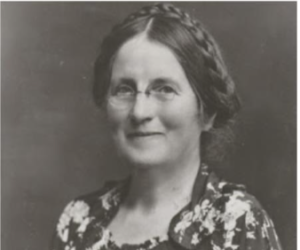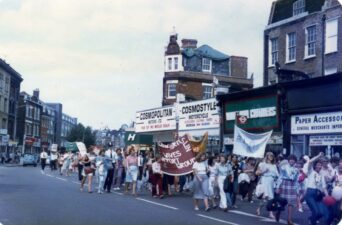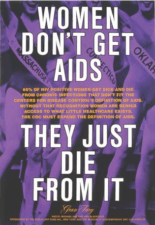Dora Metcalf (née Greene) was a mathematician and entrepreneur. Her story is one of a courageous response to loss and dauntless resilience in the face of entrenched opposition to women in business. She was born in India, the eldest of three children. Her father, George Greene from Ireland, died when Dora was 8 and the family then returned to England. From Bedford High Dora studied for an external degree in mathematics with London University (a pioneer of distance learning), earning her BA in 1911 aged nineteen. She then became a teacher at the exclusive Allenswood Academy in London.
The Great War changed everything. Dora left teaching and fell in love with the son of old friends from India. They became engaged but Lt Hugh Cass was killed at Gallipoli in 1915, leaving Dora among the heartbroken multitudes of ‘surplus women’. I looked up Hugh on Ancestry.co.uk and found him in a family tree. I messaged the tree owner and asked if any descendant might be contactable. I soon met up with his niece and her family, descendants of Hugh’s younger brother, who were thrilled to learn more about ‘Uncle Hugh’. I photographed his letters and restored them to their rightful owners.
Dora became a Comptometer operator at a munitions factory and soon saw the potential for this mechanical abacus. She began training operators and then transferred to Belfast to introduce the machines into the shipyards. As a member of the Anglo-Irish Ascendancy, Dora was acquainted with the elite of Ireland and lodged with George Clark, the owner of Workman Clark. He had opened his shipyard aged nineteen and so, when Dora was asked to set up a Belfast sales office for Comptometers in 1916, he most likely encouraged her.
Sales boomed and in 1917 Dora opened branches in Dublin and Cork. She lodged with Matilda Knowles in Dublin, a leading botanist whose apartment was the meeting place for Dublin’s revolutionary set, including Dr Kathleen Lynn, Dr Katherine Maguire (founders of St Ultan’s Hospital for women and children), Robert Barton, Erskine Childers, Diarmuid Coffey, Willie Yeats and George ‘Æ’ Russell. This unconventional and inspiring crowd strengthened Dora’s resolve.


Matilda Cullen Knowles (1864-1933) Dr Kathleen Lynn (1874-1955)
Dora used her mathematical training to build a market for information services in the commercial and government sectors. She left Ireland in 1919, due to the Anglo-Irish war, to analyse the post-war needs of British Government departments, winning the company’s largest ever order for 200 Comptometers. The 1921 British census describes her job as ‘in charge of Comptometer services for Government departments’. She returned to Belfast in 1923.
Meanwhile Dora’s cousin, Everard Greene, had co-founded British Tabulating Machines (BTM) in 1907, adapting American Hollerith machines to the British market. BTM won the contract to analyse the 1911 British census. Dora founded her own business, Calculating And Statistical Services (C&SS) in Belfast in 1924, with Everard and her friend Sam Haughton as partners – essential male credentials for winning the contract for the delayed Northern Irish census of 1926. This high profile win led to rapid growth.
She opened a Dublin office in 1929 and created an international market for information services using Comptometers and BTM tabulators, her biggest client being the Irish Hospitals Sweepstake. The internet offered brief biographies of some of the characters in Dora’s story and often included details of an individual’s associates. For example, Joe McGrath, who ran the Irish Hospitals Sweep, worked in military intelligence for the IRA, alongside Michael Joe Costello who later ran Irish Sugar, to whom Dora sold the first electronic computer in Ireland in 1957.
Dora opened a London office in 1932 and joined the exclusive Women’s Provisional Club (WPC). The club was a source of inspiration, support and business contacts throughout the rest of Dora’s career. The WPC archive at the Women’s Library in London solved various mysteries, from the surgeon who performed Dora’s gastrectomy (a member’s brother) to the photographer she chose to do portraits of my parents (Madame Yevonde) for their wedding present.
In 1934 Dora joined BTM, founding the Service Bureaux Division to build on her achievements with C&SS in Ireland, which she continued to run. BTM was very hardware driven and suspicious of this ‘feminine’ concept, but they enjoyed the profits that services generated. Dora was denied the title of Divisional Director, in spite of her role founding and running the division. Dora married naval officer John Metcalf in 1935.
In the Second World War, Dora did nationally important work that she would keep secret for the rest of her life. BTM built over 200 ‘bombe’ machines for the Enigma code breakers at Bletchley Park, known as Bureau B within BTM. The company faced strong competition for raw materials, specialist parts and labour. They had to build a new factory and find accommodation and transport for their new workers, operating 7 days a week. Dora had longstanding relationships with the various government departments and she knew how to recruit and train the women operators, making her the obvious contract manager. The National Archives held invoices from BTM and some correspondence, but nothing specifically mentioning Dora. I visited Bletchley Park but couldn’t pin down Dora’s role. I had to work it out from the shape of the gap.

Her secret project was cut short by ill health at the end of 1942 and she was demoted to less stressful work. She slowly withdrew from BTM after the war to concentrate on C&SS in Ireland. Never, in her twenty years as a divisional head at BTM, and in spite of widely admired work for St Ultan’s Hospital’s BCG vaccination programme, did her name feature in the BTM magazine. I studied the BTM archive at the Science Museum, finding only oblique reference to her achievements. The only record of her is a photograph of a successful fishing expedition.
Dora and John Metcalf retired in 1962 and left Kensington to live in a remote house in the West Highlands. Swordland Lodge had been a training centre for the Special Operations Executive in the Second World War. I haven’t found out how the Metcalfs heard of it, but I suspect one of them had a connection to someone who trained there. Local people took up my enthusiasm for Dora’s story and helped me learn more about this resolute pioneer.
Image credits: Bombe machines at Bletchley Park, author’s own. Image of Matilda Knowles from wikicommons. Attribution for the image of Kathleen Lynn is unknown. We would be pleased to update the post with proper credit.
Mary Monro is an osteopath and author of Stranger In My Heart (Unbound 2018, biography/memoir). She has written a novel based on the true story of her great aunt, Dora Metcalf (1892-1982), a founder of the Information Services industry. See www.dorapower.co.uk for more details.


